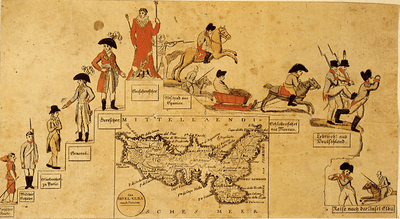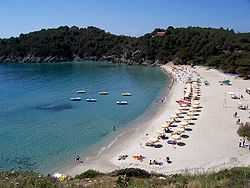Elba
| Native name: Isola d'Elba | |
|---|---|
 View of the coast (Portoferraio) of the Elba island | |
 | |
| Geography | |
| Location | Tyrrhenian Sea |
| Coordinates | 42°45.71′N 10°14.45′E / 42.76183°N 10.24083°ECoordinates: 42°45.71′N 10°14.45′E / 42.76183°N 10.24083°E |
| Archipelago | Tuscan Archipelago |
| Total islands | 7 |
| Major islands | Elba, Gorgona, Capraia, Pianosa, Montecristo, Isola del Giglio, and Giannutri |
| Area | 224 km2 (86 sq mi) |
| Coastline | 147 km (91.3 mi) |
| Highest elevation | 1,018 m (3,340 ft) |
| Highest point | Monte Capanne |
| Country | |
|
Italy | |
| Region | Tuscany |
| Province | Livorno |
| Communes of Elba | Portoferraio, Campo nell'Elba, Capoliveri, Marciana, Marciana Marina, Porto Azzurro, Rio Marina and Rio nell'Elba |
| Largest city | Portoferraio (pop. 12,013) |
| Demographics | |
| Population | 31,572 (as of Jan 1, 2009) |
| Density | 140 /km2 (360 /sq mi) |
Elba (Italian: isola d'Elba, pronounced [ˈiːzola ˈdelba]; Latin: Ilva; Ancient Greek: Αἰθαλία, Aithalia) is a Mediterranean island in Tuscany, Italy, 20 kilometres (12 mi) from the coastal town of Piombino. The largest island of the Tuscan Archipelago, Elba is also part of the Arcipelago Toscano National Park,[1] and the third largest island in Italy, after Sicily and Sardinia. It is located in the Tyrrhenian Sea, about 50 kilometres (30 mi) east of the French island of Corsica.
The island is divided into eight municipalities and is part of the province of Livorno, with a total of about 30,000 inhabitants, which increases considerably during the summer. The municipalities are Portoferraio, which is also the island's principal town, along with Campo nell'Elba, Capoliveri, Marciana, Marciana Marina, Porto Azzurro, Rio Marina, and Rio nell'Elba.
Geology
The island of Elba is the largest remaining stretch of land from the ancient tract that once connected the Italian peninsula to Corsica. The northern coast faces the Ligurian Sea; the eastern coast the Piombino Channel; the southern coast the Tyrrhenian Sea; while the Corsica channel divides the western tip of the Island from neighbouring Corsica.
The terrain is quite varied, and is thus divided into several areas based on geomorphology. The mountainous and most recent part of the island can be found to the west, the centre of which is dominated by Mount Capanne (1,018 metres/3,340 ft), also called the "roof of the Tuscan Archipelago". The mountain is home to many animal species including the mouflon and wild boar, two species that flourish despite the continuous influx of tourists. The central part of the island is a mostly flat section with the width being reduced to just four kilometres (2.5 miles). It is where the major centres can be found: Portoferraio, Campo nell'Elba. To the east is the oldest part of the island, formed over 400 million years ago. In the hilly area, dominated by Monte Calamita, are the deposits of iron that made Elba famous.
Hydrography
Rivers rarely exceed 3 kilometres (2 miles) in length, and it is common for the shorter ones to dry up during the summer. The largest rivers, sorted by length, are:
- Fosso San Francesco 6.5 kilometres (4.0 mi);
- Fosso Barion, 5.1 kilometres (3.2 mi);
- Fosso Redinoce, 2 kilometres (1.2 mi);
Between Poggio and Marciana, at the foot of Mount Capanne, is a spring called Fonte Napoleone, known for its quality.
Climate
The climate of the island is predominantly Mediterranean, except for Mount Capanne, where winters tend to be moderately cold. Precipitation is concentrated in autumn and comprises a normal rainfall. The table below shows the average temperatures for the islands by month.
| Climate data for Elba | |||||||||||||
|---|---|---|---|---|---|---|---|---|---|---|---|---|---|
| Month | Jan | Feb | Mar | Apr | May | Jun | Jul | Aug | Sep | Oct | Nov | Dec | Year |
| Record high °C (°F) | 16.2 (61.2) |
18.0 (64.4) |
20.0 (68) |
22.4 (72.3) |
29.6 (85.3) |
32.0 (89.6) |
34.3 (93.7) |
36.1 (97) |
32.0 (89.6) |
25.0 (77) |
24.6 (76.3) |
16.8 (62.2) |
36.1 (97) |
| Average high °C (°F) | 9.6 (49.3) |
10.0 (50) |
12.0 (53.6) |
14.2 (57.6) |
18.8 (65.8) |
22.7 (72.9) |
26.5 (79.7) |
26.7 (80.1) |
22.6 (72.7) |
18.0 (64.4) |
13.4 (56.1) |
10.5 (50.9) |
17.08 (62.76) |
| Daily mean °C (°F) | 7.4 (45.3) |
7.5 (45.5) |
9.2 (48.6) |
11.4 (52.5) |
15.6 (60.1) |
19.3 (66.7) |
22.7 (72.9) |
23.1 (73.6) |
19.5 (67.1) |
15.4 (59.7) |
11.2 (52.2) |
8.5 (47.3) |
14.23 (57.63) |
| Average low °C (°F) | 5.3 (41.5) |
5.0 (41) |
6.3 (43.3) |
8.5 (47.3) |
12.3 (54.1) |
15.8 (60.4) |
19.0 (66.2) |
19.5 (67.1) |
16.4 (61.5) |
12.9 (55.2) |
9.0 (48.2) |
6.5 (43.7) |
11.38 (52.46) |
| Record low °C (°F) | −7.4 (18.7) |
−4.4 (24.1) |
−5.4 (22.3) |
1.2 (34.2) |
3.4 (38.1) |
5.0 (41) |
12.2 (54) |
11.6 (52.9) |
7.6 (45.7) |
2.0 (35.6) |
−1.0 (30.2) |
−5.4 (22.3) |
−7.4 (18.7) |
| Precipitation mm (inches) | 59.5 (2.343) |
75.6 (2.976) |
56.2 (2.213) |
57.8 (2.276) |
31.6 (1.244) |
26.8 (1.055) |
13.8 (0.543) |
41.5 (1.634) |
75.0 (2.953) |
101.6 (4) |
88.7 (3.492) |
50.5 (1.988) |
678.6 (26.717) |
| Avg. precipitation days (≥ 1.0 mm) | 6.7 | 6.2 | 6.9 | 7.0 | 5.0 | 3.5 | 1.6 | 2.4 | 5.0 | 7.9 | 7.3 | 5.8 | 65.3 |
| % humidity | 77 | 76 | 75 | 76 | 76 | 73 | 68 | 72 | 76 | 80 | 81 | 79 | 75.8 |
| Mean monthly sunshine hours | 133.3 | 118.7 | 155.0 | 183.0 | 195.3 | 237.0 | 275.9 | 257.3 | 201.0 | 151.9 | 117.0 | 114.7 | 2,140.1 |
| Source #1: Servizio Meteorologico (temperature and precipitation data 1971-2000)[2] | |||||||||||||
| Source #2: Servizio Meteorologico (relative humidity and sun data 1961-1990)[3] | |||||||||||||
History

Originally inhabited by Ligures Ilvati who gave the ancient name Ilva, the island was well known from very ancient times for its iron resources and its valued mines. The Greeks called it Aethalia (Αιθαλία, "fume") after the fumes of the furnaces for the metal production. Apollonius of Rhodes mentioned it briefly in his epic poem Argonautica: the Argonauts rested here during their travels and signs of their visit were still visible in the poet's day, including skin-coloured pebbles that they dried their hands on, and large stones they used at discus. The text however may be unsound and Strabo (5.2.6) presented a slightly different account: "because the scrapings, which the Argonauts formed when they used their strigils, became congealed, the pebbles on the shore remain variegated still to this day."[4]
The island was invaded by the Etruscans and later (after 480 BC) by the Romans. In the early 11th century it became a possession of the Republic of Pisa. When the latter was sold to the Visconti of Milan in 1398, the island was acquired by the Appiani, Lords of Piombino, who retained it for two centuries.
In 1544 the Barbary pirates from North Africa devastated Elba and the coasts of Tuscany.[5] In 1546 part of the island was handed over to Cosimo I de' Medici, who fortified Portoferraio and renamed it "Cosmopoli", while in 1577 the rest of the island was returned to the Appiani. In 1596 Philip II of Spain captured Porto Azzurro and had two fortresses built there. In 1802 the island became a French possession, and its economy flourished.

Following the Treaty of Fontainebleau, French emperor Napoleon I was exiled to Elba after his forced abdication in 1814 and arrived at Portoferraio on May 3, 1814 to begin his exile there. He was allowed to keep a personal guard of six hundred men. Although he was nominally sovereign of Elba, the island was patrolled by the British Royal Navy.
During the months Napoleon stayed on the island, he carried out a series of economic and social reforms to improve the quality of life, partly to pass the time and partly out of a genuine concern for the well-being of the islanders. Napoleon stayed on Elba for 300 days. He returned to France on February 26, 1815 for the Hundred Days. After his defeat at Waterloo he was subsequently exiled again, this time to the barren and isolated South Atlantic island of Saint Helena.
In the Congress of Vienna the island was given to the Grand Duchy of Tuscany. In 1860 it became part of the new unified Kingdom of Italy.
Elba was liberated from the Germans by the French 1er Corps d'Armée on June 17, 1944 in Opération Brassard. Faulty intelligence and strong defences made the battle more difficult than expected.[6]
More recently, the island has become famed for its wine, and it is today a noted tourist resort.[7]
Transportation

The island is connected to the mainland via the three ferry companies, Toremar, Moby Lines and Blunavy, all offering routes between Piombino and Portoferraio, the capital located in the north, Cavo, Rio Marina and Porto Azzurro, on the east coast of the island.[8] [9] [10] [11] [12]
There is an airport on the island, Marina di Campo Airport. It is served by Intersky, with flights to Friedrichshafen, Munich and Zürich, and ElbaFly by internal flights.
Tourism
Cycling
The island has a network of trails for road racers looking for more technical routes for their training, trails and dirt roads for bikers to have fun on, and accessible routes for families with children who need safe and relaxing routes. On the road from Rio nell'Elba going to Porto Azzurro is the “Fonte di Coppi”. Towards the end of his career the “campionissimo” came here to train on the roads of Elba to regain his best shape. He was no longer the best Fausto Coppi but he was already a monument to cycling, set to become a hero and legend with his death that would arrive within a few years. The plaque on the fountain reads: "1960 - 2010, here the champion quenched his thirst, since fifty years on the run".
Notes
- ↑ "Elba". Parco nazionale dell'Arcipelago Toscano. 16 February 2009. Retrieved 15 January 2012.
- ↑ "ELBA/M. CALAMITA". Servizio Meteorologico. Retrieved 13 October 2012.
- ↑ Elba -Monte Calamita "MONTE CALAMITA - ELBA". Servizio Meteorologico. Retrieved 13 October 2012.
- ↑ W. H. Race, Apollonius Rhodius: Argonautica, Loeb Classical Library (2008), II.654-58, pages 381-3; see note 95 page 383 for Strabo quote.
- ↑ "Christian Slaves, Muslim Masters: White Slavery in the Mediterranean, the Barbary Coast and Italy, 1500–1800". Robert Davis (2004). ISBN 1-4039-4551-9.
- ↑ McGrann, Bill. "Operation Brassard The Invasion Of Elba". BBC. Retrieved March 2010.
- ↑ "Food and Wine". Elba Island World. Retrieved March 2010.
- ↑ "Ferries to Elba". Tuscany Live. Retrieved March 2010.
- ↑ "Ferries to the island of Elba". Ferry Elba Reservation. Retrieved March 2010.
- ↑ "Blunavy ticket reservation (EN)". Blunavy. Retrieved June 2011.
- ↑ "Toremar ticket reservation (IT)". Toremar. Retrieved June 2011.
- ↑ "Moby Lines ticket reservation (EN)". Moby Lines. Retrieved June 2011.
References
- Chandler, David G. (1990). The Illustrated Napoleon. New York: Henry Holt & Co. ISBN 0-8050-0442-4.
Gallery
-

-

West coast of Elba
-

Fetovaia beach
External links
| Wikimedia Commons has media related to Elba. |



